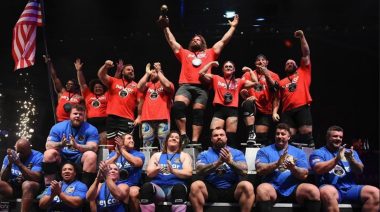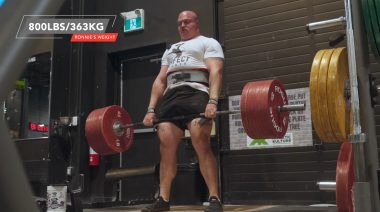When it comes to creating programs to improve athletic performance, many coaches are aware that variety can be important, especially when an athlete gets bored with their training. However, too many changes to a program might make it less effective.
In a recent Journal of Strength and Conditioning Research study, investigators looked into whether strongman training would be a good way to change up a program without losing any results.
Study Design
In the study, thirty rugby players were divided into two groups. The groups performed either strongman-style training or a more traditional training program twice per week for seven weeks.
The traditional training method included the following exercises:
- Clean and jerk
- Deadlift
- Military press
- Back squat
- One-arm row
The strongman training involved using similar weights and exercises that worked similar muscles and ranges of motion.
- Log lift (essentially a clean and jerk with a log)
- Farmer’s walk
- Axle press (a thick bar military press)
- Heavy sled pull (like a truck pull)
- Arm-over-arm sled pulls
The groups went through two rounds of tests. The first were the strength tests. For this round, athletes were tested on their one rep maxes for clean and jerk, deadlift, military press, squat, and bent-over row.
The second tests were performance measures, which were standard sport tests that many athletes perform during tryouts. For example, the subjects did a thirty-meter sprint, a change of direction test, and jumps. These tests also included a few non-traditional ones, like a sled push and a medicine ball chest throw. The second group of tests perhaps better mimicked what the strongman style training might give the athletes, since most of the strength tests were similar to or the same as the first protocol.
Results
There were advantages and disadvantages to either method of training, but one thing is for certain: both methods were effective. In fact, for the most part, they were similarly effective. In the performance measure test results, there were no significant differences between the groups at all.
There were some small differences the researchers noted. The strongman group gained a little more muscle mass and accelerated a little faster. They also had a dramatically larger bent-over row by the end. Not surprisingly, the traditional training group was a little better at the squat and deadlift by the end, and they had a little bit better performance on the broad jump and pivoting speed in their change of direction test. Oddly, they also performed a little better on the sled push test.
Bear in mind, however, that the only major difference between the two was the bent-over row. The strongman group had a greater improvement over traditional training by over twenty pounds. The strongman group also added some muscle while losing weight, while the traditional group experienced no gain in muscle and some gain in fat.
Conclusions
One important takeaway from this study is that multiple methods can be effective at developing strength, power, and muscle. As a result, it’s probably best for athletes to choose the type of training they find most enjoyable, since they will put the most effort into it as a result.
The researchers also pointed out that these methods can be used to spice up an athlete’s training without fear of losing results. Since many athletes can become complacent and bored with a given routine, these results may give coaches more options in their tool belt to create effective and fun programs.
References:
1. Paul Winwood, et. al., “Strongman versus traditional resistance training effects on muscular function and performance,” Journal of Strength and Conditioning Research, DOI: 10.1519/JSC.0000000000000629
Photo courtesy of CrossFit Empirical.






